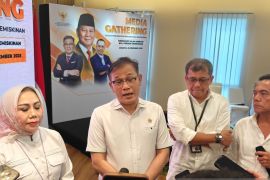The Central Bureau of Statistics (BPS) in 2018 revealed that the poverty rate in Indonesia had dropped to the lowest as compared to the ratios in the earlier periods.
The number of people living below the poverty line dropped to 25.95 million, or 9.82 percent of the population in March 2018, from 27.77 million, or 10.64 percent of the population, a year earlier.
BPS head Suhariyanto had told reporters in Jakarta on July 16, 2018, that nationally, the number of people categorized as poor in March 2018 had decreased 1.82 million from a year earlier.
The success achieved in reducing the poverty rate was attributable to all priority programs of the government, such as infrastructure development for better connectivity; village funds; improvement in logistics distribution; and several social allowances for health, family welfare, and education.
Related news: President says Indonesia needs poverty eradication heroes
Related news: Social Affairs Ministry to cut poverty rate to below nine percent
However, despite the success, President Joko Widodo (Jokowi) has reminded citizens that alleviating poverty and reducing the social gap remained persistent challenges and homework that necessitated all-encompassing efforts.
Speaking on National Heroes Day themed “I am a Hero of the Present” and observed on Nov 10, 2019, Jokowi called for heroic figures keen to fight poverty, ignorance, and inequality.
During the post-independence era, the nation requires to continue its struggle, but this time it is to combat poverty, ignorance, backwardness, and inequality, Jokowi stated.
The president remarked that despite Indonesia having successfully reduced its poverty rate to a historical low of 9.66 percent in 2018, from 10.96 percent in 2014, the government had yet to revel in this achievement.
"We are not satisfied with it. We yet have to accomplish several things, while on the hand, we are facing a shortage of time. We only have 11 years left to achieve the target of SDGs," he remarked.
The president is targeting to reduce the poverty rate to below nine percent.
"He (the president) has ordered that the poverty rate be cut further to below nine percent," new Social Affairs Minister Juliari Peter Batubara had stated in October 2019.
The new minister remains resolved to attain the target in spite of the challenges of the globalization era.
"This is not easy, but it would be a record if we manage to suppress the national poverty line to below nine percent," he stated.
The PDIP politician is upbeat about achieving the target, which is the lowest ever.
The target is also in tune with the government's programs to boost the development of human resources and to create more job opportunities as well as to increase economic growth.
"I think we in the cabinet must ensure that our programs are in line with the president's vision and mission," he remarked.
Related news: Poverty remains major problem in Indonesia: ACT chief
The government’s intervention is indeed deemed necessary to help lower the poverty rate.
However, Ahyuddin, chairman of the advisory board of ACT (Swift Response and Action), expressed belief that generosity can help eradicate poverty that remains a glaring problem in Indonesia.
"Poverty is a humanitarian affair. Humanitarian action does not only concern natural disasters or people being displaced due to conflict or war," he remarked in Bandung, West Java, on Nov 21, 2019, following the launch of the Humanity Rice Truck expedition program.
The ACT focuses on humanitarianism, generosity, and volunteerism to aid in addressing the country's problems concerning poverty.
"I believe that however grave the problem of poverty is, it could be solved if this nation becomes a generous one," he stated.
He called on more Indonesians to become volunteers in dealing with humanitarian problems.
To deal with poverty, the ACT focuses on providing food, such as rice, for the poor. He proposed a program called "Rice for Indonesian mothers."
This is since it is the mothers that harbor the deepest concerns when their families have no food to eat.
The ACT provides 250 tons of rice monthly for the poor. It means the humanitarian NGO distributes rice to two thousand families daily, or 50 thousand families monthly.
By 2020, the ACT is upbeat about providing rice to 500 thousand families across Indonesia with donations from the public.
In the meantime, the Government of Indonesia is prioritizing the development of Independent Prosperous Village (DSM) as part of its efforts to address poverty in border regions.
Earlier, the World Bank had advised that better logistics will boost the country's competitiveness and also help lower poverty by reducing the prices of goods and services in remote regions, especially in Eastern Indonesia.
Related news: World Bank approves US$300 million for poverty reduction in Indonesia
Related news: State budget should encourage prosperity among Indonesian people
Editor: Sri Haryati
Copyright © ANTARA 2019












